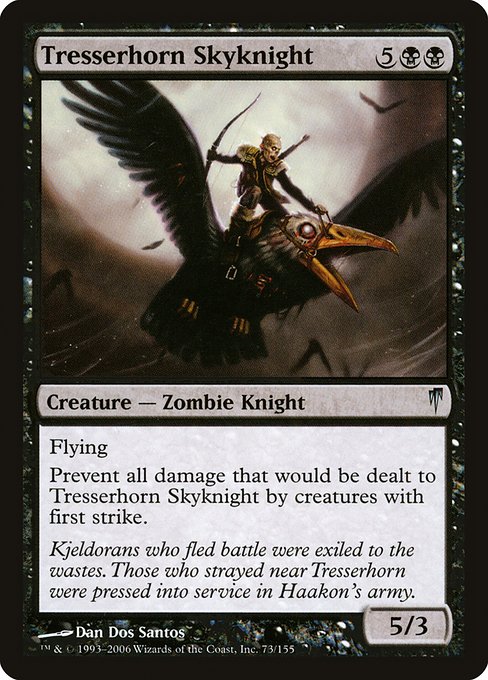
Image courtesy of Scryfall.com
From Concept to Card: Lessons in Designing a Black Zombie Knight
Design is a conversation between concept and play. When we set out to shape a creature like Tresserhorn Skyknight, we’re balancing mood, mechanics, and the long arc of how a card will feel across formats. This uncommon black zombie knight arrives with a striking mix: a hefty 7-mana investment, flying, and a protective twist that mutely nudges how opponents interact with it. The result isn’t just a stat line; it’s a design edge that invites strategic decisions every time you untap. 🧙♂️🔥
First, consider the mana cost and body. A 5/3 flyer at seven mana is powerful enough to demand attention, but the real work comes from its ability: “Prevent all damage that would be dealt to this creature by creatures with first strike.” That line doesn’t just grant resilience; it reframes combat expectations. It says, in effect, “This is a durable threat that wants to dodge early hits from the most common fast attackers.” Designers must be mindful of how such a clause interacts with the broader ecosystem—how does it feel in limited play, how does it scale in older formats, and how does it align with black’s identity as a color that values inevitability and attrition? The Skyknight threads in that classic contrast between heavy commitment and stubborn endurance. ⚔️
Flavor and function walk hand in hand here. The card sits in the Coldsnap universe, a setting steeped in frostbitten conflict and stark loyalties. Its flavor text—“Kjeldorans who fled battle were exiled to the wastes. Those who strayed near Tresserhorn were pressed into service in Haakon's army”—grounds the mechanical choice in a narrative reality. Designers often weave this kind of lore into the rules text: the flying knight is not just a random creature with a gimmick; it embodies the menace of armies that rise from exile and endure through layers of hardship. When flavor and mechanics reinforce each other, players feel the magic in their bones, not just in their decks. 🎨
“Great design isn’t numbers alone; it’s a story you can test in the middle of a crowded battlefield.”
Another design takeaway is the balancing act between power and versatility. The Skyknight’s manacost ensures it remains a late-game threat, but its ability preserves it against the usual openers from aggressive first-strike teams. It’s a reminder that a well-timed static-like effect can create meaningful decision points for both players. Will your opponent attempt to push through with first-strike creatures, or pivot to other threats that bypass the Skyknight’s special protection? In a world where first strike has historically built quick tempo, a design that tampers with that tempo can open the door to more nuanced games—especially in multiplayer formats where players juggle resource denial, board presence, and late-game inevitability. 🧙♂️🧭
From a collector and collector-play perspective, Tresserhorn Skyknight’s rarity—uncommon—fits the archetype of a standout but not overpowering edge case. Its art by Dan Dos Santos, the evocative atmosphere, and the dual nature of vulnerability and resilience all contribute to a card that’s desirable for both sleeves and sleeves-off conversations. In a broader sense, this is a case study in how rarity, artwork, and lore coordination can elevate a card from “cool” to “iconic within a set.” And yes, the foil version adds even more shine, which is a subtle nudge toward market value that designers shouldn’t ignore when building a flagship for a block. 💎
So what practical takeaways emerge for a budding designer or a curious player? Start with the core identity you want for the color and class. Black, here, leans into resilience and attrition—an aggressive, intelligent counterplay that rewards careful planning. The flying keyword scales well with a fearsome cost, but the standout is the protective nuance against first-strike damage. If you test this in a design sandbox, watch for edge cases: how does it fare against mass removal, how does it feel to opponents who rely on first strike to finish the job, and how does the flavor text reinforce the lore without overexplaining the mechanic? The aim is a visage that players recognize on sight and a function they remember after a match ends. 🧙♂️🔥
Finally, remember that design lives at the intersection of art and play. The Skyknight’s silhouette, the pale frost of Coldsnap, and the weight of a seven-mana investment all converge to tell a single story: a relentless, airborne sentinel whose defenses force a shift in how battles unfold. When you can thread that needle—mechanics, flavor, and art in concert—you’re not just making a card; you’re expanding the world a little bit more for every MTG fan who loves to theorycraft, collect, and duel. ⚔️🎲
For fans who want to keep their game on the go with flair, a neon card holder phone case can be a perfect companion—something practical that also nods to the neon glints of a well-worn deck box. If you’re curious, the Neon Card Holder Phone Case MagSafe Polycarbonate is a stylish companion that travels as well as your board state does.
Neon Card Holder Phone Case MagSafe Polycarbonate